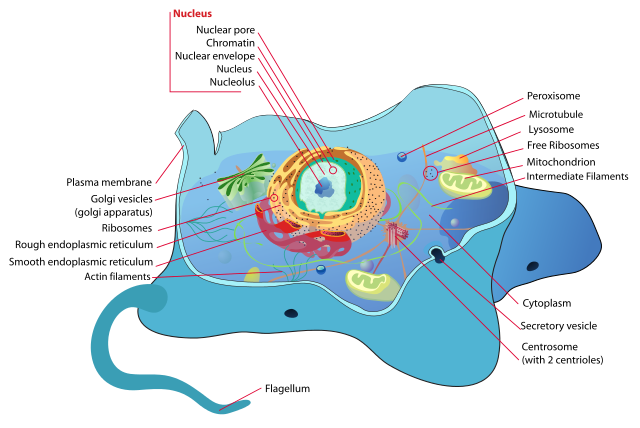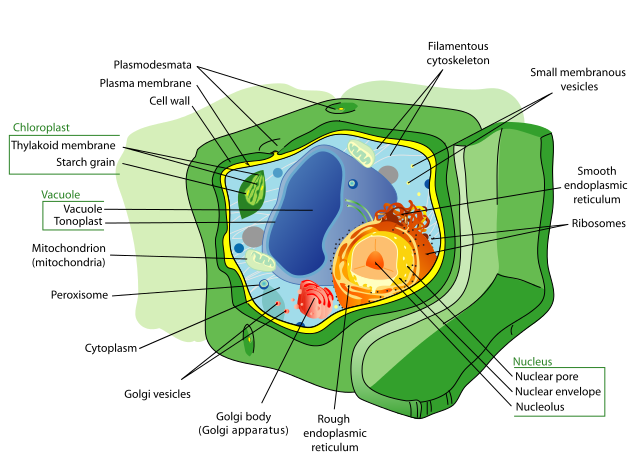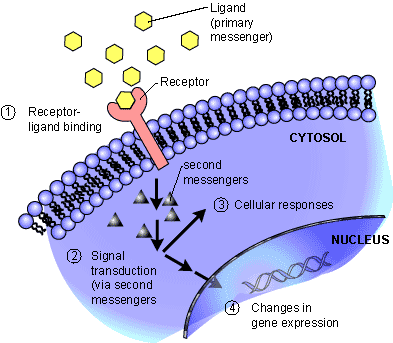CELL BIOLOGY VIA SEVENTEEN-SYLLABLES: LESSONS THROUGH HAIKUS
Introduction
Since I have a fierce love for cell biology (I did complete my BSc. in Molecular, Cell and Developmental Biology, after all), what follows is a brief overview of cell biology that someone in grade 12 could understand.
We start with animal and plant cells, and the various organelles in each before we marvel at cell signaling for a moment, and then take a quick look at how cells use the processes of transcription and translation to produce proteins from a gene. Each section begins with a descriptive paragraph and helpful visuals, and is concluded by a series of related haikus.
I chose haikus to communicate these topics because the limitation of seventeen syllables really ensures that only the key words are included, and that they are easy to understand.
I enjoyed writing these haikus about cell biology. I hope you enjoy reading them.
– – –
I. The Animal Cell
The cells that make up our bodies are animal cells (Figure 1), and differ in their structure and function from plant cells. We, and other animals, are eukaryotes. Eukaryotes are organisms whose cells have a proper nucleus and other organelles. The nucleus is the part of the cell that contains the genes (DNA) that encode all of the proteins our cells make. Organelles are subunits within the cell that perform a specialized function. They are enclosed in a membrane, which allows for the different organelles to perform their jobs without interfering with each other. For example, the ribosomes build proteins and lysosomes break down proteins. If the enzymes of the lysosomes were not kept physically separate from the rest of the cell by its membrane, it would be very difficult for the cell to function properly.

Figure 1: A Typical animal cell and its organelles (By LadyofHats, via Wikipedia)
The functions of the organelles are roughly defined as follows:
Nucleus: Contains DNA/genes, controls activities of the cell
Ribosome: Makes proteins
Endoplasmic Reticulum (ER): Network of membrane-enclosed tubes
Rough ER: embedded with ribosomes, builds proteins
Smooth ER: lack ribosomes, builds fats and sugars
Transport Vesicles: move proteins or fats between locations in the cell
Secretory Vesicles: excretion of materials from the cell
Lysosomes: break down foods or damaged organelles
Golgi Complex: Labels proteins and ships them to other parts of the cells (like a post office) Transports fats. Produces lysosomes.
Mitochondrion: Makes energy for the cell (ATP)
Proteasome: Breaks down unneeded proteins
The Haikus: Organelles
Eukaryotes have
membrane-enclosed organelles
proper nuclei
Organelles allow
compartmentalized functions
lipid bilayers
Nucleus holds genes
Genes control the cell’s actions
The brain of the cell
To make proteins well
will need lots of ribosomes
on ER or free
Smooth ER makes fats
gluconeogenesis
builds sugars also
Vesicles carry
transport materials
to their destinations
Special vesicles
break down damaged organelles
these are lysosomes
The Golgi complex
modifies and packages
proteins to be shipped
Mitochondria
powerhouses of the cell
ATP for all
The proteasome
proteins tagged for destruction
are broken down here
– – –
II. The Plant Cell
Plant cells (Figure 2) have many of the same organelles as animal cells. They contain all the ones covered in the last section, and also have some unique ones. These include the vacuole, chloroplasts, cell wall, and plasmodesmata. Plant cells have a large central vacuole, which holds a large volume of water. The amount of water held in the vacuole determines the plant cell’s turgor pressure. Turgor pressure allows plants to stand tall when there is lots of water in the cell. When there is little water in the vacuole, the turgor pressure drops, and the plant wilts. It is very important for plant cells to have stores of water. Water is a necessary component for photosynthesis – the process plants use to create sugar from sunlight – to take place. Chloroplasts are specialized structures that are also necessary for photosynthesis, since they absorb sunlight. The cell wall is another structure that distinguishes plant cells from animal cells. It provides physical support and protection to the plant, and also contains little openings called plasmodesmata. Plasmodesmata allow small molecules through for cell-to-cell communication.

Figure 2: A Typical plant cell and its organelles (By LadyofHats, via Wikipedia)
Organelles specific to plant cells and their main functions include:
Vacuole: Holds water
Chloroplast: Absorbs sunlight – photosynthesis
Plasmodesma: Allows small molecules to pass between cells. Cell-to-cell communication
The Haikus: Plant Cells
Water is super
important for any cell
vacuole holds lots
Stores more than water
vacuole contains waste to
protect rest of cell
Turgor pressure high
plant stands against gravity
low, plant starts to wilt
Photosynthesis
sugar from light energy
done by chloroplasts
Carbon dioxide
water, light energy, make
sugar, oxygen
Cell wall to provide
structure, support, protection
made of cellulose
Plasmodesmata
singular: plasmodesma
cell-to-cell signals
– – –
III. Cell-to-Cell Communication
It was mentioned in the last section that plant cells have special openings (plasmodesmata) in their cell walls that allow them to pass signals to other cells. Cells can communicate with nearby cells! (I have a degree in cell biology and this continues to blow my mind.) There are three stages of cell communication: reception, transduction, and response. Reception allows a cell to detect a signaling molecule when it binds to a receptor. This binding causes a change to the receptor, which starts the transduction process. Sometimes transduction is a change in only one molecule, but it often requires changes of a series of proteins. This is known as a signaling pathway (Figure 3). Finally, the cell responds in some way, such as building a new protein that it wasn’t making before the signal. Transcription factors are a special type of protein that can enter the nucleus and bind to DNA to promote the production of other proteins.

Figure 3: An example of a basic signaling pathway. A signal (ligand) binds to a receptor, which causes a variety of changes inside the cell (second messengers). These, in turn, make their way to the nucleus where transcription (trans) of new genes is activated. (By Fan Sozzi, via scq.ubc.ca)
The Haikus: Cell Communication
Three stages of cell-
to-cell communication
bind, transduce, respond
Cell sends a signal
binds to a cell’s receptor
here we start the dance
Receptor changes
signaling pathway active
cell responds some way
To the nucleus
is a transcription factor
produce new protein
Transcription Factors
decide which genes make proteins
turn genes on or off
Cells can talk to cells
signaling cascade commence
“stop growing, I’m here”
– – –
IV. From DNA to Protein
So cells can talk to one another, and these signaling pathways can result in a transcription factor promoting the production of specific proteins in response to the initial signal. But how does a cell take a sequence of DNA, or a gene, and turn this into a protein? Cells do this by processes called transcription and translation. First the DNA sequence that encodes for a protein is transcribed into a messenger RNA (mRNA). Then the mRNA is used as a template, and ribosomes translate the message and match the corresponding amino acids to build the final protein. Since DNA and RNA both use nucleic acids in their sequences, these languages are very similar, which is why this process is called transcription. Amino acids, on the other hand, are very different from RNA. There are very specific combinations of nucleotides that code for the different amino acids. Therefore the sequence must undergo translation to be changed from an RNA sequence to a protein.
The Haikus: Transcription and Translation
DNA close to
same language as RNA
therefore transcription
Translation needed
to turn RNA into
expected protein
Both transcription and
translation have the same steps
start, lengthen, and stop
Initiation
elongation lengthens strand
termination stops
To make protein, first
RNA Polymerase
transcribes DNA
Produce RNA
transport out of nucleus
bound by ribosome
tRNA bring
amino acids to bind
together form chain
Polypeptide chain
folds specifically to form
functional protein
– – –
References:
Karp, G. (2010). Cell and Molecular Biology: Concepts and Experiments. USA: John Wiley and Sons, Inc.